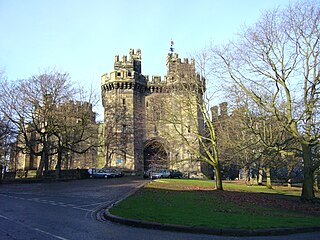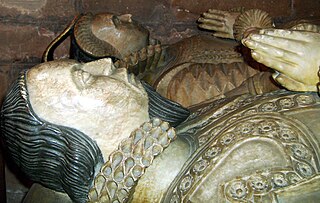Related Research Articles

John Jewel of Devon, England was Bishop of Salisbury from 1559 to 1571.

The term Derby Gaol historically refers to the five gaols in Derby, England. Today, the term usually refers to one of two tourist attractions, the gaol which stood on Friar Gate from 1756 to 1846 and the cells of which still exist and are open to the public as a museum, and the 1843 to 1929 Vernon Street Prison whose impressive frontage can still be seen today.
Thomas Fitzherbert was an English Jesuit.
John Gerard was a priest of the Society of Jesus who operated a secret ministry of the illegal and underground Catholic Church in England during the Elizabethan era. He was born into the English nobility as the second son of Sir Thomas Gerard at Old Bryn Hall, near Ashton-in-Makerfield, Lancashire.
Nicholas Garlick was an English Catholic priest, martyred in Derby in the reign of Queen Elizabeth I.

Richard Gwyn, also known by his anglicised name, Richard White, was a Welsh school teacher and Bard who wrote both Christian and Satirical poetry. A Roman Catholic during the reign of Queen Elizabeth I of England, Gwyn was martyred by being hanged, drawn and quartered for high treason at Wrexham in 1584. He was canonised by Pope Paul VI in 1970 as one of the Forty Martyrs of England and Wales. Since its creation in 1987, Richard Gwyn has been the Patron Saint of the Roman Catholic Diocese of Wrexham. Along with St. Margaret Clitherow, Gwyn is also the co-patron of the Latin Mass Society of England and Wales. His feast day is on 17th October.
Francis Tregian the Elder (1548–1608) was an English recusant and landowner in Cornwall. He was arrested and imprisoned, and later pardoned.
Thomas Haydock (1772–1859), born of one of the oldest English Catholic Recusant families, was a schoolmaster and publisher. His dedication to making religious books available to fellow Catholics suffering under the English Penal Laws came at great personal cost. He is best remembered for publishing an edition of the Douay Bible with extended commentary, compiled chiefly by his brother George Leo Haydock. Originally published in 1811 and still in print, it is one of the most enduring contributions to Catholic biblical studies.
Nicholas Fitzherbert was an English recusant gentleman who served as secretary to Cardinal William Allen and was found guilty of treason due to his Catholicism. He was the second son of John Fitzherbert of Padley, Derbyshire. Fitzherbert was the grandson of the judge Sir Anthony Fitzherbert (1470–1538), and first cousin to the Jesuit Thomas Fitzherbert. Whilst he was abroad, two priests were arrested at his father's house; they are now saints after becoming martyrs to their faith. Fitzherbert's lands were forfeit, and he was obliged to spend his life abroad. He was buried in Florence.

Edward Oldcorne or Oldcorn alias Hall was an English Jesuit priest. He was known to people who knew of the Gunpowder Plot to destroy the Parliament of England and kill King James I; and although his involvement is unclear, he was caught up in the subsequent investigation. He is a Roman Catholic martyr, and was beatified in 1929.
Sir John Talbot of Grafton, Worcestershire was a prominent recusant English Catholic layman of the reigns of Elizabeth I of England and James I of England. He was connected by marriage to one of the Gunpowder Plot conspirators, and by acquaintance or family ties to other important Catholic figures. He fell often under suspicion from the English government.
The Oaten Hill Martyrs were Catholic Martyrs who were executed by hanging, drawing and quartering at Oaten Hill, Canterbury, on 1 October 1588. The gallows had been put up in 1576. These four were beatified by Pope Pius XI in 1929.

The Samlesbury witches were three women from the Lancashire village of Samlesbury – Jane Southworth, Jennet Bierley, and Ellen Bierley – accused by a 14-year-old girl, Grace Sowerbutts, of practising witchcraft. Their trial at Lancaster Assizes in England on 19 August 1612 was one in a series of witch trials held there over two days, among the most famous in English history. The trials were unusual for England at that time in two respects: Thomas Potts, the clerk to the court, published the proceedings in his The Wonderfull Discoverie of Witches in the Countie of Lancaster; and the number of the accused found guilty and hanged was unusually high, ten at Lancaster and another at York. All three of the Samlesbury women were acquitted.
Sir Humphrey Winch (1555–1625) was an English-born politician and judge. He had a distinguished career in both Ireland and England, but his reputation was seriously damaged by the Leicester witch trials of 1616, which resulted in the hanging of several innocent women.
Rowland York or Yorke was an English soldier of fortune and defector to Spain.
Sir Robert Pointz or Poyntz (1588–1665) was an English landowner and politician. He sat in the House of Commons for Gloucestershire, between 1626 and 1629.

John Giffard (1534–1613) was a Staffordshire landowner and Member of the English Parliament, notable as a leader of Roman Catholic Recusancy in the reigns of Elizabeth I and James I.
John Hart was an English Jesuit, known for his equivocal behaviour on the English mission in the early 1580s.
Sir Jerome Alexander (c.1585–1670) was an English-born barrister, judge and politician who spent much of his career in Ireland and became a substantial Irish landowner. He was a noted benefactor of Trinity College Dublin. As a judge he was so ruthless in securing guilty verdicts in criminal cases, and in imposing the death penalty on the guilty parties, that for many years after his death "to be Alexandered" was an Irish synonym for being hanged.
Berisford is a surname. Notable people with the surname include: